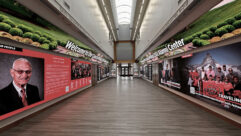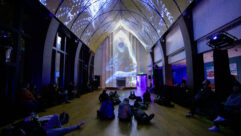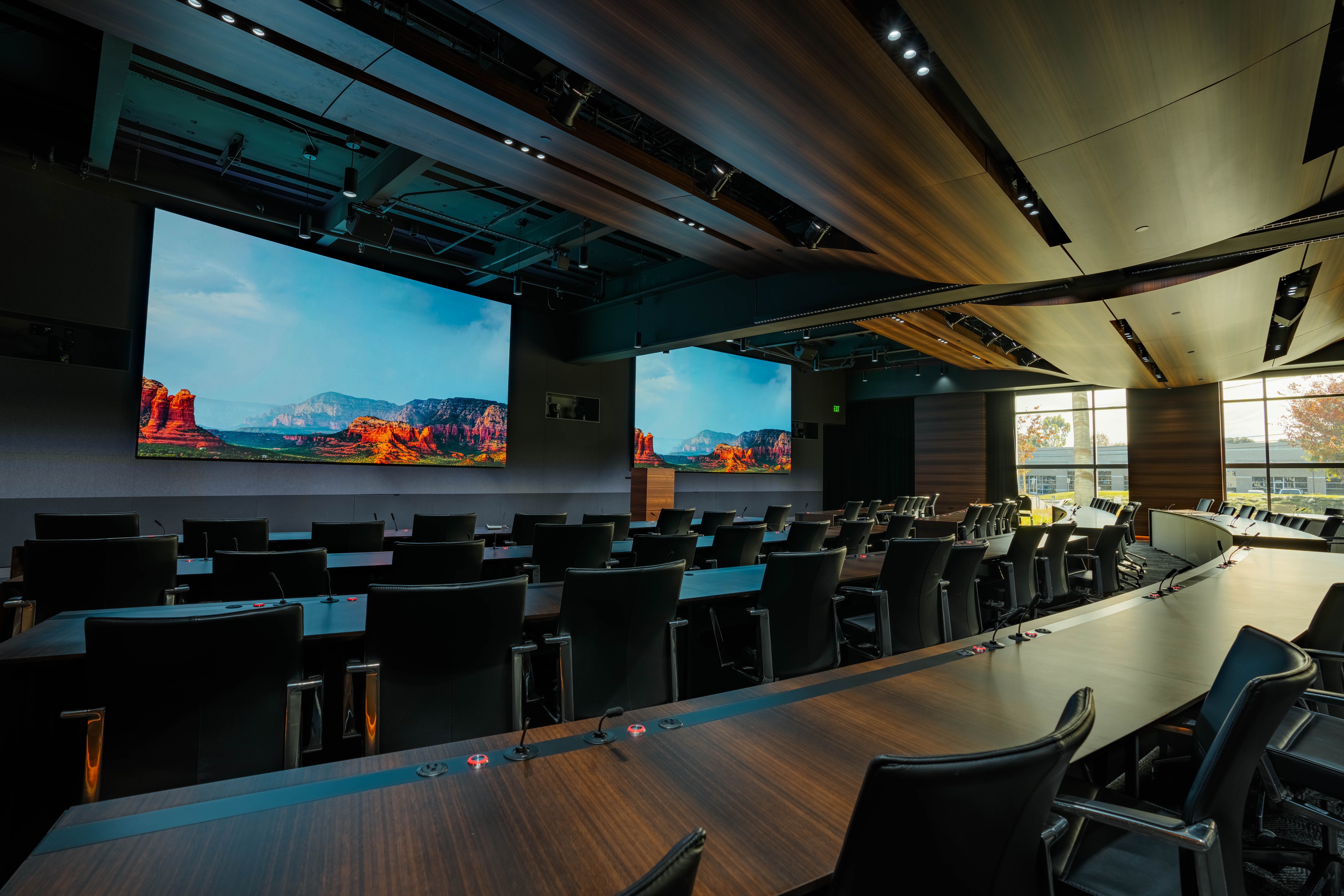
Corporate Canvas
Sep 23, 2013 3:34 PM,
By Cynthia Wisehart
Making digital spaces work

In the senior executive conference room, an NEC WXGA 5500 lumen projector on an automatic Draper lift keeps a discreet profile when not in use.
Corporations use AV for public-facing communication and for internal workflow. The bar is rising on both those fronts; AV is taking a more critical role in corporate goals whether for efficiency, collaboration, sales, customer relations, or marketing.
When David Weatherhead and Mark McPherson of Toronto-based Advanced AV explain their charter for the $50 million, new-build GE Digital Energy headquarters in Markham, Ontario, they talk about digital spaces and pixel counts—but not as dry technical ideas. Instead they see them as facets of human communication. The digital space is a canvas; the pixel count represents the amount (and clarity) of data that moves across the space. The power and flexibility of AV systems directly affects the quality of human communication within the building. This in turn can improve competitiveness and profitability.
Accomplishing all this over an IP backbone (and in cooperation with the IT department of a multi-national corporation) is a big order. The year-plus design process started with detailed conversations about client goals and the reasons behind them. GE saw AV as central to a public-facing space—an ambitious, high-impact “experience” center. Behind the scenes, GE also wanted interactive collaboration for some 55 meeting and training rooms within the new headquarters, which was also to be the gateway to offices all over the world.
The goal was to support all forms of collaborative communication—from a sleek senior executive conference room to ad hoc meeting spaces that employees could grab for a quick meeting, to videoconferencing setups of varying sizes and complexities that could be scaled for meetings, training, or presentations as needs arose.
The GE project suited the way Advanced works in two very particular ways—it drew on their niche as videowall experts, and their role as a veteran Smart Technologies dealer. The result incorporated high-impact displays—including the largest curved Prysm Laser Phosphor Display wall in the world—and a lot of interactivity through touchscreens, iPad, and Polycom integration.

AV helps drive sales to GE’s enterprise and government customers; the interactive presentation system runs on the largest curved Prysm LPD wall in the world.
The Experience Center
“For the Experience Center, we wanted to create a very large-scale immersive video wall,” recalls Advanced co-president Weatherhead. We looked at everything—LCD, rear projection, even LED.” When Prysm exhibited its Laser Phosphor Display for the first time at InfoComm 2011, “it seemed perfect to create that high-impact, immersive experience the client was envisioning,” says Advanced VP McPherson. “It had great viewing angles (178 degrees), small bezels (.02mm), tiny seams, plus a good environmental story behind it.” Excited by the potential, Advanced purchased a demo system in the fall in 2011 and started living with the technology. “By the time GE came into our showroom to take a look, we really understood it,” McPherson says. GE executives then flew to New York to see a big demo wall there.
Since this would be the largest Prysm installation to date, a team of Advanced engineers travelled to Prysm’s headquarters in San Jose, Calif., to undergo extensive training. Advanced also completed a week of constant assembly/de-assembly of the videowall panels to practice what the engineers learned (an exercise that came in handy when the real installation had to take place in and around construction). Advanced next built a 50-tile test wall on the GE site, so content creators could be sure that images would work on the 58ft., 175-tile, 180-degree wall.
The enormous wall is the centerpiece of the center and delivers an informative, controlled show powered by an Extron Quantum Elite processor. Visitors—often major electricity entities and government representatives from throughout the world—fill out an electronic questionnaire and are tagged via their guest pass badges. A host with an iPad (running a Crestron app and Advanced software) can then direct questions to individuals based on their pre-loaded responses, and control content on the big screen to support answers and dialogue. Zoned audio (via Biamp, Crown, and Tannoy) supports all the visitor station displays—a series of eight narrative AV stations—and along the length of the Prysm wall.
GE thought that this kind of dramatic, high-touch digital interaction would be a memorable way to teach customers and sales prospects about GE’s digital energy products and modern methods of energy conservation. The wall itself is a powerful green symbol since it’s power usage and heat footprint are so low (about 1/10 of the power required for other display options of the same size) and no cooling system or replacement lamps are required.
When customers exit the experience center they can use their guest passes with the interactive touchscreens to instantly upload their personal contact information, request follow-up information on GE’s products and services, as well as leave feedback about the presentation they just viewed.
Corporate Canvas
Sep 23, 2013 3:34 PM,
By Cynthia Wisehart
Making digital spaces work
Constant Collaboration
On the employee side of the house, most of the meeting spaces in the 200,000-square-foot building have interactive LCD Smart displays that allow people to annotate and collaborate with others—including people not physically in the office. Through automated moveable walls, many of the spaces can be reconfigured. Advanced deployed videoconferencing systems that blend Polycom and Smart Technologies whiteboards, touchscreens, and collaboration software.
AV technology is the spectacular centerpiece of the visitors’ center, and prominent throughout the headquarters, but in the senior executive conference room it is nearly invisible. Discreet flush-mount conferencing mics embed in the leaf-shaped table. Overhead, a similarly shaped structure mirrors the table with lighting and houses a retractable NEC WXGA, 5500-lumen projector on a Draper automated lift.
McPherson says that Advanced sees interactive collaboration as important enough to dedicate two salespeople solely to that discipline. The company provides consultation and training to make sure that clients not only get the collaboration system they think they want but one they will actually use and keep using.
At GE, an onsite tech stayed to trouble shoot and train the large group of new users. In fact, Weatherhead emphasized that one of the most important challenges of the job was not technology, but people. GE is a large company and integrating users was just as important as integrating gear. Further, he says, they needed to work effectively with an IT department that was remote to the building and already serving thousands of users. Having people on the Advanced staff who were Microsoft-certified helped bridge the trust gap. “Those certifications are just going to be more important as time goes by,” McPherson say.
Weatherhead adds that the other thing that will be more important as time goes by is visual impact, flexibility, and spontaneity in collaboration. That means more videowalls and high-impact displays, and also processing power to incorporate spreadsheets, videoconferencing, whiteboard annotation, and many other kinds of data and image sources onto these displays as needed. “You want a cross-discipline skill set; clients want more pixels in their buildings, whether for customer experience or to get more out of meetings,” Weatherhead says.
Just a few weeks ago, Advanced put this same kind of pixel-intensive collaborative approach to work for Air Canada when the airline relocated its operations center to a new facility in Toronto. As with GE, the goal was to integrate the AV systems into the lifeblood of the enterprise. Once again the combination of high-impact videowalls and Smart interactivity served them well.
Looking Ahead: Prysm Collaboration Videowall Solutions
In May, Prysm announced two new standard products for collaboration meeting rooms: a 117in. diagonal videowall for medium-sized rooms and a 190in. diagonal videowall for large rooms. These rooms are designed to increase team productivity by enabling the convergence of user-generated content, telepresence, and collaborative applications into a unified experience on a large digital canvas. The new videowalls use Cisco TelePresence codecs and cameras; users can move and interact naturally through the combination of camera coverage, efficient encoding, and a broad visual canvas for presenting both people and content. Applications and video can be shared in real time around the globe.
Looking Ahead: Smart and Microsoft Lync

Smart’s software bridges between their interactive displays and Polycom videoconferencing systems in configurable training rooms.
Advanced flags the combination of Smart Technologies interactive products and Microsoft Lync for videoconferencing as poised for growth. “Smart recently came out with software that taps into the power of Microsoft Lync,” Advanced VP Mark McPherson says. “It’s easier to integrate with the IT manager since they are likely already on the Lync system. It’s really exciting to think of extending the desktop Microsoft Lync experience into the boardroom.” AVI-SPL has also recently completed certification to sell the Smart Technologies room system for Microsoft Lync in the UK.









